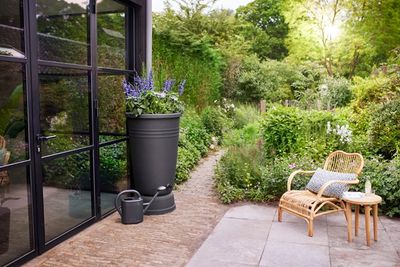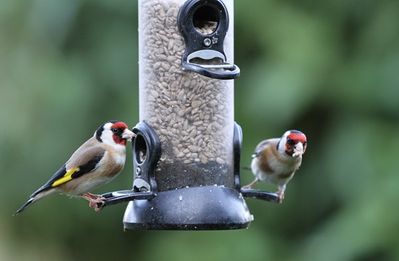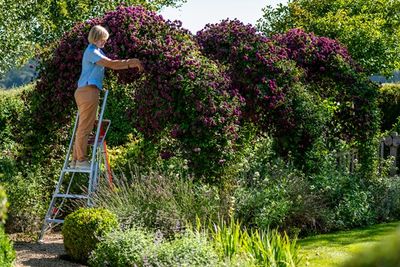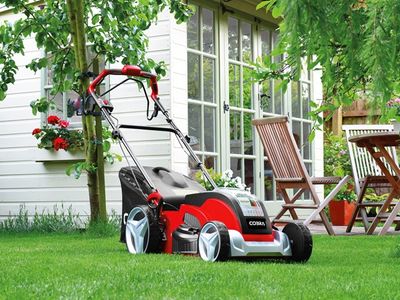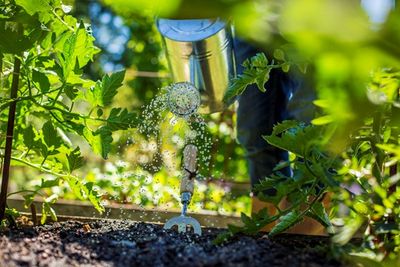Expert comments from across the gardening sector on Spring garden jobs 🌼
Published:
Read Time: 10 mins
As spring approaches, many of your readers will be looking for inspiration and expert advice to help them prepare their gardens. To make your job easier for you, we've compiled some top tips from each of our clients that we hope will be of interest. Our handy guide to essential spring jobs includes:
🌼 Scattering wildflowers 🌼
🌹 Planting bare root roses 🌹
✂️ Pruning hedges ✂️
🐦⬛ Feeding the birds 🐦⬛
🌿 Using liquid seaweed 🌿
🌷 Adding spring colour 🌷
💧 Harvesting rainwater 💧
🌱 Preparing your lawn 🌱
So keep on reading for our experts' top tips!
Get outdoors with the kids and start scattering wildflowers
Dr Emily Lambert, conservation scientist and co-founder of wildflower company, Seedball:
"Growing wildflowers is a fantastic way for children to connect with nature. It's so simple and kids of all ages can scatter Seedballs, water them, and watch as tiny seedlings grow into beautiful plants. Even a small patch of wildflowers becomes an exciting space to explore, buzzing with fascinating insects like ladybirds, lacewings, and grasshoppers.
“Starting the process by planting the seeds gives children a sense of ownership and pride in the flowers they grow. When the blooms have done their job, there’s even the opportunity to collect new seeds from the spent flowers to plant elsewhere or share with friends and family. Seeds come in all shapes and sizes, many tucked inside pods that can be dried and emptied. Poppy seed pods are especially fun—they scatter their seeds in the wind like tiny saltshakers! These seeds can be sown directly onto bare soil in autumn or spring, starting the cycle all over again."
Install a water butt and harvest rainwater
Patty Willems, PR Manager of sustainable plant pot company, elho, advises on adding a water butt to the garden.
“Make the most out of spring showers by adding a water butt to the garden! Rainwater provides the freshest and cleanest water, as well as being a great money-saving alternative to the mains supply. Plants actually prefer to drink rainwater as it does not contain minerals like calcium and fluoride. It is also much better for the environment, as it preserves our planet’s precious water supplies!
“Rain barrels and water butts are a great way of harvesting rainwater for the garden, and many can easily be installed to drainpipes. The elho green basics rain catcher has a handy 35-litre capacity and a handy tap at the bottom, perfect for filling up your watering can and refreshing thirsty plants and flowerbeds. The rain catcher not only provides an environmentally friendly source of water, but it is also made from 100% recycled plastic and is 100% recyclable. Your plants will be kept perfectly hydrated while helping save water and energy by not using your taps!”
Feed the birds
Garden wildlife expert and founder of Ark Wildlife, Sean McMenemy said:
"Spring is a vital time for garden birds, especially as the busy breeding season begins as early as February. Offering a steady supply of high-quality food gives adult birds the energy they need to prepare and care for their young.
“Keeping your feeders filled up with high-calorie and protein rich foods is a great way to give mum and dad a much-needed boost. Foods such as black sunflower seeds are rich in fat, protein, and essential oils. Fat balls are another excellent option. Ark’s premium suet fat balls are made with top-quality animal and vegetable fats, plus added sunflower and mixed seeds for extra nutrition. With their high-fat content, every beakful delivers a calorie-dense boost, essential for busy birds caring for their young. Just make sure you regularly clean your feeders as this helps prevent the spread of nasty diseases and germs.
“Supporting the parents means helping the next generation thrive. The best part? Seeing fledglings visit your garden - a heartwarming reminder of the difference you’ve made!”
Prune flowering shrubs
The best place to cut a stem
Where a bud is visible, prune just three to four millimetres above it, to prevent leaving a long ‘snag’ which could die or encourage disease. For a clean cut on young stems, use Bypass Pruners from Wilkinson Sword which have a cutting diameter of up to 22mm.
Cut any dead or old branches from the base of the plant to encourage strong new growth. If more force is needed, use Ratchet Loppers which will provide greater leverage and reduce effort for the user. Where stems are crossing over or growing too close together, remove one to allow the other space – also eliminating the risk of them rubbing together which could cause damage to the bark or disease.
When to prune
For plants that flower in the summer or autumn, the best time to prune them is in late winter or early spring – ready for the year ahead. Spring bloomers will fare best with a good prune after their flowers begin to die. Herbaceous perennials should be cut in the late winter and can be taken down to ground level, leaving the clump of leaves at the base.
Different pruning techniques
‘Pinching’ is the mildest type of pruning and is exactly what it sounds like – using your fingers or a pair of scissors to pinch off small amounts of vegetation at the tips of branches. For branches that need more severe pruning, use Wilkinson Sword Classic Bypass Pruners to shorten branches or stems back to a good bud. For overcrowded bushes or those with dead branches, thin out entire stems all the way to the main branch, trunk or the soil line.
Add plants for spring colour
Expert advice from Emma Fell, Head of Horticulture at Hillier Garden Centres and Nurseries
"Spring is the perfect time to start adding vibrant colour to your garden with plants like cyclamen and primroses. Cyclamen, known for its delicate buds and pretty hues of pink, purple, and white, is a versatile choice. Hardy varieties such as Cyclamen ‘Coum’ and Cyclamen ‘hederifolium’ are perfect for adding a splash of colour to the grey winter garden.
"They do best when planted in shaded spots under trees, high-branched shrubs, rock gardens, or along the edges of borders. Blooming from late summer to early spring, these perennials bring a touch of joy to the garden even in the colder months. They also thrive in baskets and containers, making them ideal for small or unique spaces.
“Primroses are another excellent option for early spring planting. These native British wildflowers are easy to grow and come in a variety of colours and forms. Whether scattered among borders or planted in pots, primroses can transform your garden into a stunning tapestry of colour. To plant them, make sure to space them 6 to 12 inches apart and place them 4 to 6 inches deep in moist soil. As they are part-shade lovers, primroses are fantastic when planted underneath shrubs and trees. Water them thoroughly after planting and keep the soil moist throughout the season by adding a layer of mulch.”
Give shrubs and trees some TLC
Steve Swanborough, gardening expert at Henchman advises on giving trees and shrubs some care this spring:
“Spring is an excellent time to trim back trees and shrubs. Not only does it give your garden a tidy appearance, but it also ensures plants grow strong and healthy throughout the season.
"Start by using a pruning saw to cut away smaller branches, working your way up to larger ones. Remove any dead, diseased or damaged branches to help prevent disease and promote new growth. Preserve the tree’s natural shape and structure as much as possible, thinning the crown to allow sunlight and air circulation. Make sure to remove crowded or weak branches to improve the plants overall health.
“As most pruning work is done at height, it’s important to use a specialist ladder to keep you safe. Henchman’s Fully Adjustable Tripod Ladder will keep users stable, even on rough or uneven terrain. With plenty of support and space to move comfortably, you can easily tackle high branches without worrying about your safety. It’s also worth having a pair of durable gloves with good grip and a ground sheet to make cleaning up a little easier. With Henchman ladders, no branch is out of reach, allowing gardeners to easily keep trees well-maintained and healthy.
Plant bare root roses
Liam Beddall, Senior Rose Consultant at David Austin Roses, provides some top tips on how to get the most from bare root roses:
1. Selecting the right bare root roses
Choosing the right bare root rose for you is the first step. With countless options from climbing roses and hybrid teas, to floribundas and shrub roses, there are plenty of varieties to suit every taste.
2. Soaking the roots
Before planting, soak the roots of your bare root rose for at least two hours, or overnight if possible.
3. Preparing for planting
Before planting, it’s essential to prepare the area properly. Bare root roses prefer well-drained soil rich in organic matter. Make sure your planting site gets at least four hours of sunlight each day. Good air circulation is crucial to prevent disease, so avoid areas with poor airflow or strong winds.
5. Mulching and watering
After planting, apply a layer of mulch around the base of the rose to help retain moisture, prevent weeds, and regulate soil temperature. Keep the soil consistently moist, but be sure not to overwater, as soggy soil can lead to root rot.
6. Pruning and maintenance
Bare root roses don’t require any pruning at first, while younger plants that have flowered for one or two seasons require a light prune, and roses that have bloomed for more than two or three summers can be reduced in size by half. Once the roses start to grow, remove any dead or diseased wood and shape the plant as needed. Be sure to keep an eye out for pests and diseases, and treat them promptly with appropriate remedies.
7. Fertilisation and care
Roses are heavy feeders. To encourage healthy growth and abundant blooms, use a rose-specific fertiliser, such as the Controlled Release Rose Food. Apply fertiliser in the spring and throughout the growing season as directed, being careful not to over-fertilise.
Get your lawn ready for spring
As Spring approaches, there’s plenty to be doing to get your lawn looking its best for the season ahead. Here’s some expert tips from Peter Chaloner, Managing Director of Cobra:
1. Before anything else, clear the lawn of any debris.
2. Scarifying and aerate to remove unwanted thatch and let lawns breathe.
3. Overseed the lawn to make it thick and lush - it can make a huge difference to patchy areas.
4. Tackle the first mow of the year when conditions are dry but raise the mower height to the maximum setting to avoid scalping the lawn.
5. Keep grass cuttings! They act as a great mulch that lock in moisture and nutrients, helping to grow thick, healthy grass.
6. Don’t fertilise the grass until the soil is moist, or when rain is expected so as to avoid scorching the lawn.
7. Go beyond mowing and sharpen lawnmower blades, check spark plugs, clean air filters, change oil and make sure all safety functions are working.
Enhance your soil health
Angharad James, product manager at Maxicrop, discusses how to improve soil health:
“Ensuring your soil is in top condition is an essential as we head into the growing season, and adding natural soil amendments can work wonders for the health of your soil.
"Seaweed-based products like Maxicrop’s All Purpose Growth Stimulant are an excellent way to restore and maintain soil health. Enriched with high-quality seaweed extract sourced from Norwegian waters, Maxicrop is a must-have for enhancing plant vitality from the ground up.
"This natural stimulant improves root development, making it easier for plants to absorb essential nutrients from the soil. Whether you’re growing flowers, shrubs, trees, fruits, vegetables or maintaining a lawn, Maxicrop helps ensure that your plants have a healthy foundation. It stimulates natural growth processes, making sure that plants get the nutrients they need to grow strong and resilient. Simply mix 45ml of the stimulant into 9 litres of water and apply it directly to your plants every seven to 14 days. As an organic-approved product, it’s safe for both your garden and the environment.”
Ends
Editors notes
Honest Communications is a PR, communications and social media agency specialising in working with home, lifestyle and garden brands. In just five years, it has become the go-to agency for many of the best brands in the industry both, in the UK and Europe. It offers its clients the perfect blend of creativity and strategic thinking, working with companies to put their products and services in front of the right people, in the right place, at the right time.


